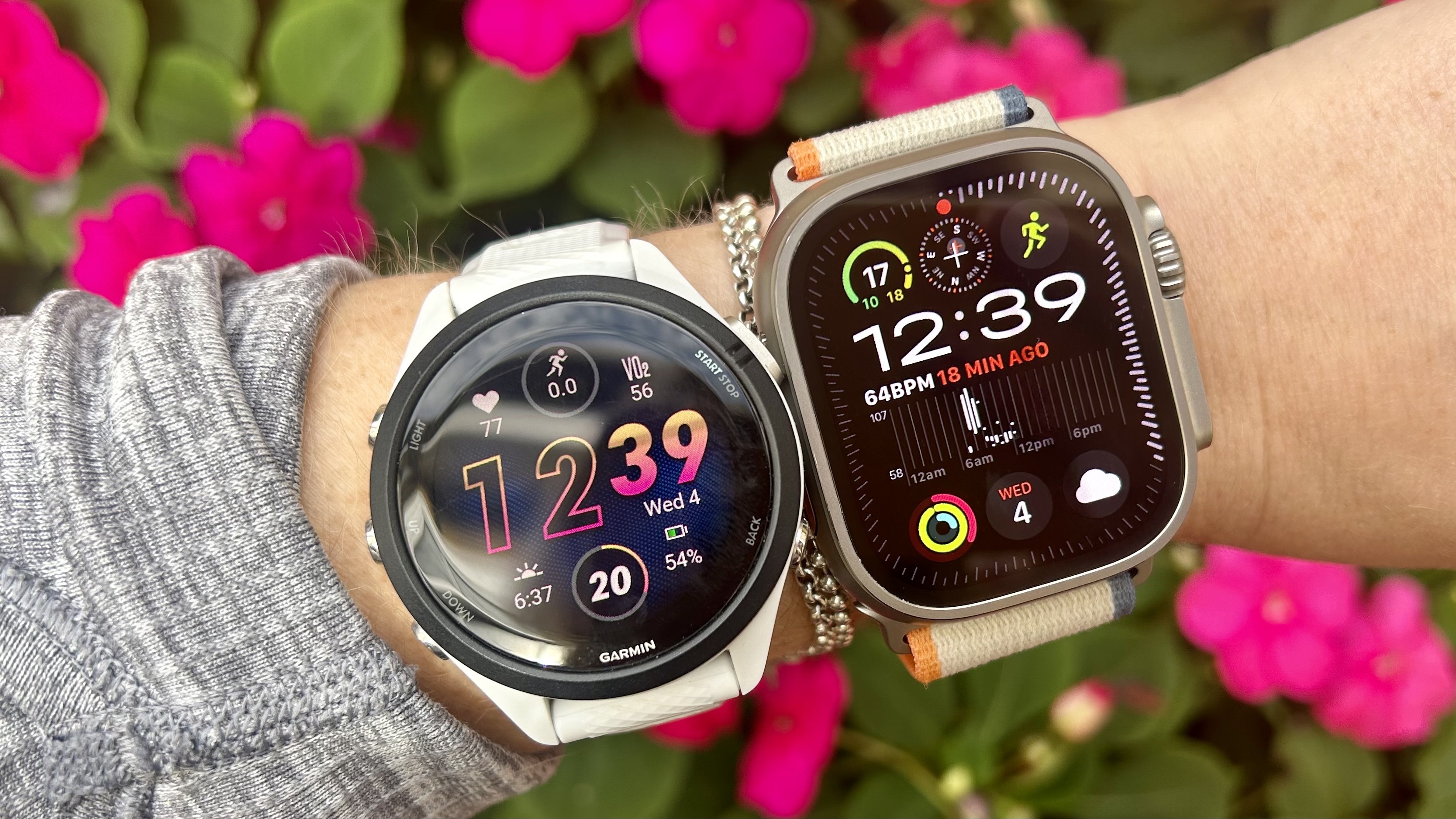I walked 8,000 steps with Apple Watch Ultra 2 and Garmin Forerunner 265 — here’s which was more accurate
I put the two watches head-to-head

When it comes to the best running watches on the market, most of them will do an awful lot more than just track your runs, calories burnt, and steps taken. Designed to be worn 24/7, most GPS watches will also track sleep, your heart rate, and your skin temperature sensor. That said, if you are looking to track your steps, you might be wondering whether Apple or Garmin is more accurate.
I’ve already tested the step-count accuracy on the Apple Watch Series 9 and Garmin Forerunner 265 by strapping both to my wrist and manually counting 8,000 steps. This time, I put the Apple Watch Ultra 2 and the Garmin Forerunner 265 to the test. Read on to find out what happened.
Before delving into my stats, let’s start by taking a look at how the best fitness trackers on the market count your steps. Both the Apple Watch Ultra 2 and the Garmin Forerunner 265 track how many steps you’ve taken by using an internal accelerometer, which measures the swing of your arm. Each swing counts for two steps. It doesn’t matter whether you wear your watch on your dominant or non-dominant hand, or whether you’re walking with your hands in your pockets, or holding something, the accelerometer should still measure your body’s movement.
I walked 8,000 steps with the Apple Watch Ultra 2 and Garmin Forerunner 265 — here's what happened
For this test, I strapped both watches to my wrist and set out for a walk. Rather than counting in my head, to try and make things more accurate, I used a manual clicker counter from Amazon, and clicked every time I took a step — it cost $7, and if you’d like to give this a go yourself (I warn you now, it’s pretty dull), you can buy your own here. When I got home, I compared the data from the two watches.
The 8,000 steps took me just over an hour. My Garmin Forerunner 265 recorded a walk of 3.77 miles in one hour and six minutes. My Apple Watch Ultra 2 recorded a walk of 3.8 miles in one hour and seven minutes. Compared to the Apple Watch Series 9, the Ultra 2 has multi-band GPS, making it more accurate. The Forerunner 265 also has multi-band GPS.
This isn’t the first time I’ve completed an experiment like this, and I’ve learned in the past that Apple makes it nearly impossible to view your exact amount of steps per workout. Sure, you can see your daily total in the Fitness app, and you can find hourly step data in the Health app, but to make things a little less confusing, I downloaded the StepsApp Pedometer app on my Apple Watch.
The results
| Row 0 - Cell 0 | Total steps |
| Manual step counter | 8,000 steps |
| Apple Watch Ultra 2 | 7,990 steps |
| Garmin Forerunner 265 | 8,004 steps |
When looking at the data, I was surprised — this is one of the closest accuracy tests I’ve done to date, and the Apple Watch Ultra 2 was more accurate than the Apple Watch Series 9 was when I did this test. This time, the Apple Watch Ultra 2 was ten steps out, and the Garmin Forerunner 265 rounded up by four steps. Of course, to truly test the accuracy of the two watches, you’d need to do a lot more testing on a much bigger scale, but I was impressed at how pretty much spot-on the two watches were.
Get instant access to breaking news, the hottest reviews, great deals and helpful tips.
Of course, there’s a huge difference between the two watches. The Garmin Forerunner 265 is definitely positioned as more of a sports watch, costing $449/£429. The Apple Watch Ultra 2, on the other hand, is an adventure smartwatch costing $799, making it a lot more expensive than the Garmin.
Perhaps a fairer test from a price perspective would have been between the Garmin Epix Pro vs Apple Watch Ultra 2. That said, for a lot less money, Garmin's device has a lot of advanced fitness tracking metrics; if you’re after a smartwatch, though, the Forerunner 265 falls short. On the other hand, the Apple Watch Ultra 2 is one of the best smartwatches on the market and is like wearing an iPhone on your wrist — it’s undoubtedly the best Apple Watch to buy if you’re doing any serious training.
It’s also worth pointing out that counting steps alone isn’t the best metric when it comes to getting fitter and losing weight. That said, it’s a good place to start. Although the 10,000 steps per day message started as a marketing campaign, a review of 32 studies, published in the International Journal of Behavioral Nutrition and Physical Activity found that “10,000 steps/day is a reasonable target for healthy adults.”
10,000 steps is the equivalent of walking around 5 miles per day, which might sound like a lot, but might mean taking the stairs, not the elevator, getting off the subway a couple of stops early, or meeting a friend for a walk at lunch, not sitting in a coffee shop. There are a number of benefits of walking more, including losing weight, building muscle, and feeling less stressed. Here’s what 30-minutes of walking each day can do for your body.
More from Tom's Guide
- I walked 11,000 steps with Apple Watch Ultra 2 and Apple Watch Series 9 — and one was more accurate
- Fitbit Charge 6 vs. Fitbit Charge 5 — Here’s what’s changed
- I walked 8,000 steps with the Apple Watch Series 9 and the Fitbit Inspire 3 — and one was way more accurate

Jane McGuire is Tom's Guide's Fitness editor, which means she looks after everything fitness related - from running gear to yoga mats. An avid runner, Jane has tested and reviewed fitness products for the past five years, so knows what to look for when finding a good running watch or a pair of shorts with pockets big enough for your smartphone. When she's not pounding the pavements, you'll find Jane striding round the Surrey Hills, taking far too many photos of her puppy.
